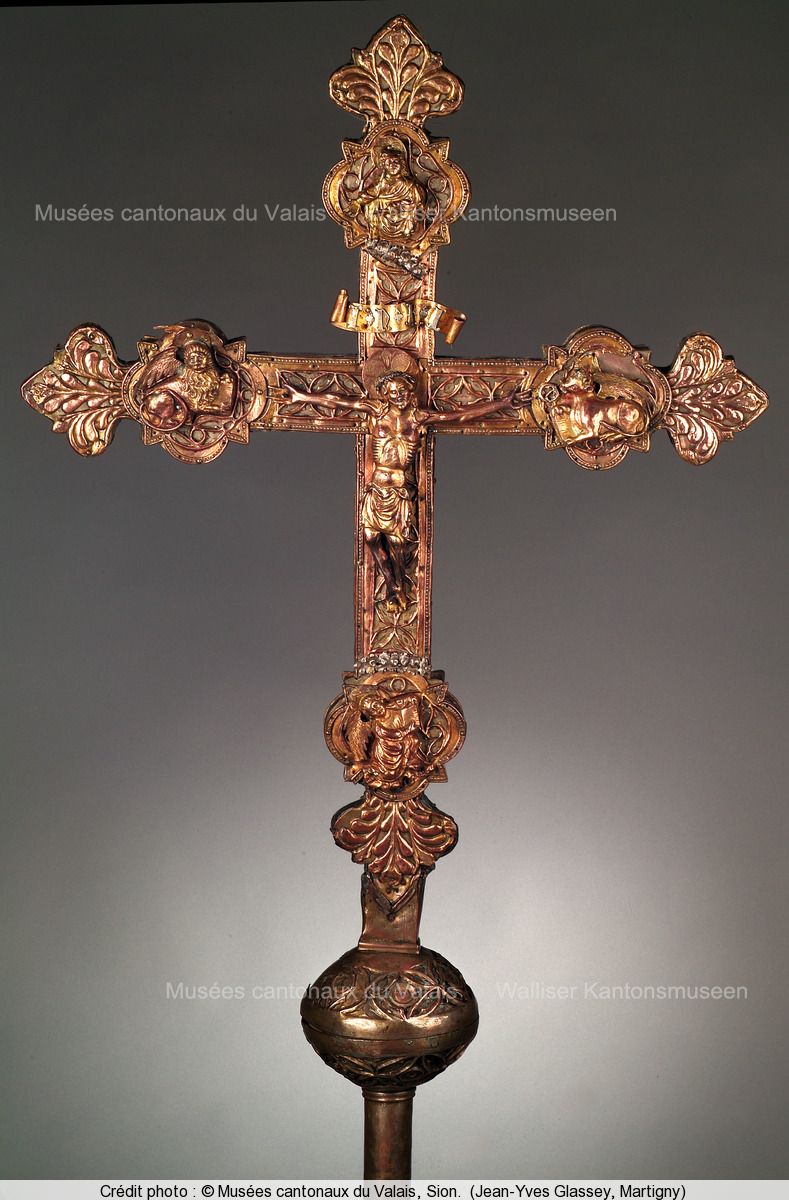Croix de procession

Romaine Syburra-Bertelletto, 2013 :
Héritière des grandes croix de procession des XIe-XIIe siècles qualifiées de « façon byzantine » ou de « travail limousin » que conservent encore l’hospice du Grand-Saint-Bernard et, jusqu’à une date récente, la basilique de Valère (volée en 1984), cette croix de procession s’insère dans la lignée des croix de procession du XVe siècle présentant le Christ crucifié entouré des quatre Évangélistes.
Composée de plaques de cuivre doré clouées sur une âme en bois, la croix s’élève d’un nœud sphérique terminé par une douille qui recevait la hampe lors des processions. Les décors géométriques ou végétaux sont obtenus par repoussage et gravure alors que les figures, Christ et symboles des Évangélistes, sont traitées en ronde-bosse et rapportées dans les espaces réservés. Sur la face, la croix fleuronnée reçoit le Christ crucifié et, aux extrémités, les symboles des Évangélistes contenus dans des quadrilobes. Au bas prend place l’homme ailé de saint Matthieu, à droite le taureau ailé de saint Luc et à gauche le lion ailé de saint Marc. Omettant saint Jean, le compartiment supérieur est réservé au Christ de la loi. Au revers, le centre est occupé par le Christ juge alors que les trois quadrilobes supérieurs ont perdu leurs figures. Seul subsiste au bas un personnage agenouillé en prière.
De nombreux exemplaires de ce type sont encore conservés dans les paroisses à l’origine liées au Grand-Saint-Bernard, telles Bourg-Saint-Pierre, Lens, Liddes ou encore Vouvry. Provenant d’Orsières, la croix présentée au musée est également à placer dans l’orbite de l’hospice. Son décor imitant des remplages à soufflets tournoyants indique qu’elle est plus récente que les autres exemplaires bagnards et qu’elle date vraisemblablement du début du XVIe siècle.
"Croix de procession", in: Elsig Patrick, Morand Marie Claude (sous la dir.), Le Musée d’histoire du Valais, Sion. Collectionner au cœur des Alpes, Sion: Musée d’histoire/Paris: Somogy Ed. d’Art, 2013, pp. 152-153.
Romaine Syburra-Bertelletto, 2013 :
Das Vortragekreuz MV 1601 steht in der Nachfolge der im Hospizschatz auf dem Großen Sankt Bernhard und bis vor kurzem im Kirchschatz von Valeria (das Valeriakreuz fiel 1984 einem Kunstraub zum Opfer) aufbewahrten großen Vortragekreuze des 11. und 12. Jahrhunderts, die als „Limoger Arbeit“ oder „byzantinisch beeinflusst“ gelten. Es kann in eine Reihe von Vortragekreuzen des 15. Jahrhunderts gestellt werden, die jeweils Christus am Kreuz, begleitet von den vier Evangelisten, darstellen.
Das Vortragekreuz MV 1601 besteht aus einem Holzkern, der mit vergoldeten Kupferblechen beschlagen ist und nach unten hin mit einem sphärischen Knauf und einer Tülle, durch die der Vortragestab geschoben wurde, abschließt. Die Blattmotive und geometrischen Muster sind getrieben oder graviert, die Figuren des Gekreuzigten und der Evangelistensymbole vollplastisch ausgeführt und an speziell zu diesem Zweck freigelassenen Stellen angebracht. Auf der Vorderseite umgeben die an den Kreuzarmenden in Vierpassformen angebrachten Evangelistensymbole die Figur des gekreuzigten Christus: unten der geflügelte Mensch (Matthäus), rechts der geflügelte Stier (Lukas) und links der geflügelte Löwe (Markus). Der Johannesadler am oberen Kreuzende wurde zu Gunsten einer Figur von Christus als Gesetzgeber weggelassen. Auf der Rückseite ist an der Kreuzmitte die Figur von Christus als Weltenrichter angebracht. Die Figuren der drei oberen Vierpassformen sind verloren gegangen. In der Vierpassform des unteren Kreuzarmendes ist eine kniende betende Figur erhalten geblieben.
Zahlreiche ähnlich ausgeführte Vortragekreuze befinden sich heute in ehemals vom Großen Sankt Bernhard abhängigen Pfarreien wie Bourg-Saint-Pierre, Lens, Liddes oder Vouvry. Auch das aus Orsières stammende Vortragekreuz MV 1601 gehört zum Einzugsgebiet des Hospizes vom Großen Sankt Bernhard. Die an Maßwerke mit Fischblasen erinnernde Ornamentik weist stilistisch auf eine gegenüber den anderen Vortragekreuzen aus dem Bagnes-Tal etwas jüngere Herstellungszeit und lässt das Kreuz MV 1601 ins frühe 16. Jahrhundert datieren.
"Vortragekreuz", in: Patrick, Morand Marie Claude (Hrsg.), Das Geschichtsmuseum Wallis, Sitten. Sammeln inmitten der Alpen, Sitten: Geschichtsmuseum Wallis/Paris: Somogy Ed. d’Art, 2013, S. 152-153.
Romaine Syburra-Bertelletto, 2013 :
This descendant of the great processional crosses of the 11th and 12th centuries in the “Byzantine manner” or “Limousin work” preserved at the Great St. Bernard Hospice, or until recently, at the Basilica of Valère (stolen in 1984), is a typical example of the 15th-century processional crosses that showed the crucified Christ flanked by the four evangelists.
The cross is made of gilt brass plates nailed onto a wooden core and stands on a spherical knob with a socket for the shaft. The geometric and plant motifs that decorate it were worked in repoussé and engraved, while the figures of Christ and the evangelists were done in the round and fitted into reserves. The front of the trefled cross shows the crucified Christ with the symbols of the evangelists in the quatrefoils at the ends. At the bottom is the winged figure of a man for Matthew, on the right the winged ox of Luke, on the left the winged lion of Mark. Instead of John, the top compartment shows the Christ of the Law. On the back, Christ the Judge is in the centre; three of the quatrefoils have lost their figures, leaving only that of a man kneeling in prayer at the bottom.
Many examples of this type of cross are still preserved in the parishes originally associated with the Great St. Bernard Pass, such as Bourg-Saint-Pierre, Lens, Liddes and Vouvry. The cross presented here comes from Orsières, and so also belonged to the hospice’s sphere of influence. The decoration imitating curvilinear tracery speaks for a later dating than the other examples from Bagnard; probably the early 16th century.
"Processional Cross", in: Elsig Patrick, Morand Marie Claude (Ed.), History Museum of Valais, Sion. Collecting in the heart of the Alps, Sion: Musée d’histoire/Paris: Somogy Ed. d’Art, 2013, pp. 152-153.

